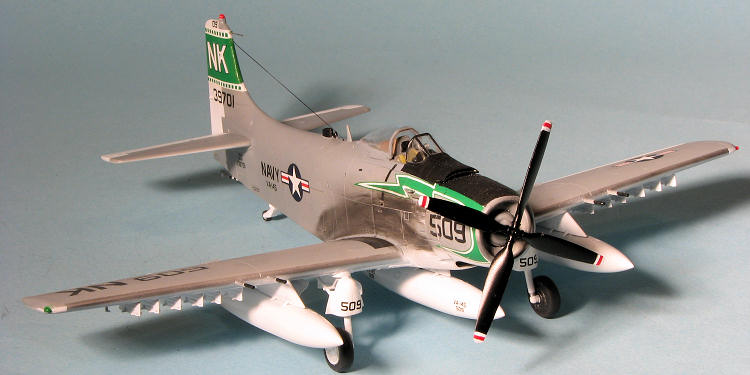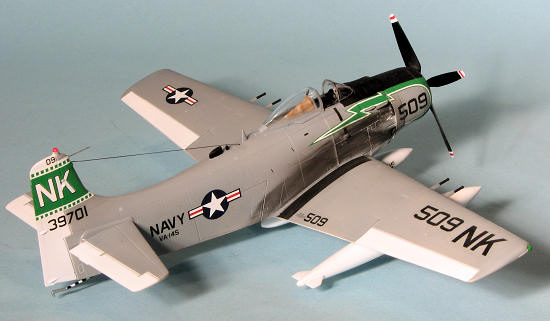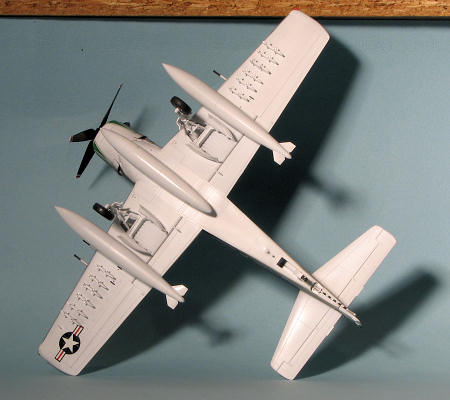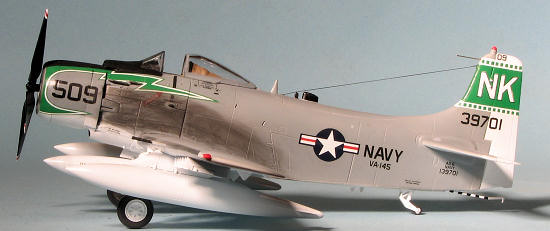
Hasegawa 1/72 A-1H Skyraider
| KIT #: | 51406 |
| PRICE: | $16.95 when new |
| DECALS: | Two options |
| REVIEWER: | Scott Van Aken |
| NOTES: | 1996 boxing |

| HISTORY |
The first AD-1 Skyraider was delivered in 1946 and named according to the Douglas tradition of starting the names of Navy aircraft with "sky." When the Navy, Marine Corps and Air Force numbering systems merged in 1962, the "AD" series Skyraiders were redesignated as "A" series aircraft.
Before production ceased in 1957, 12 years after the airplane was introduced, Douglas built 3,180 Skyraiders in 28 variations. These included carrier- or land-based airplanes, day or night attack bombers, and versions for photographic reconnaissance,  electronic countermeasures, airborne early warning, utility and search missions.
electronic countermeasures, airborne early warning, utility and search missions.
Different configurations carried a pilot in an enclosed cockpit, a pilot and another person (either a radar operator or a co-pilot), and a pilot and two other crew. The AD/A-5 could carry a crew of four, plus four passengers or 12 troops, four stretchers, or 2,000 pounds of cargo.
During the Korean conflict, the Skyraiders entered service over the Korean Peninsula in October 1951, and by 1955, there were 29 Navy Skyraider squadrons on carriers.
In 1964, it was modified for service in the Vietnam War, redesignated A-1E/A-1H, and used by the U.S. Navy and the U.S. and South Vietnamese air forces. Because of its ability to carry large bomb loads, absorb heavy ground fire and fly for long periods at low altitude, the Skyraider was particularly suited for close-support missions. The type was also used by the French and some were later sold to Chad.
| THE KIT |
Dated 1996, this may well be the initial boxing of the Hasegawa Skyraider. Previously, Airfix, Fujimi, and Tsukuda all did the A-1, but this one eclipses those in terms of detail. Molded in medium grey plastic and up to the usual standard of Hasegawa with engraved panel lines, and the use of small poly caps to hold in the prop. The cockpit is adequate with a seat, s tick and control panel all fitting into the cockpit tub. Decals are used for instruments. Judging from what looks like a canvas cover over the area behind the cockpit, it seems this kit has the Yankee extraction system, something that I'm pretty sure was was not used on most Navy A-1H Skyraiders.
tick and control panel all fitting into the cockpit tub. Decals are used for instruments. Judging from what looks like a canvas cover over the area behind the cockpit, it seems this kit has the Yankee extraction system, something that I'm pretty sure was was not used on most Navy A-1H Skyraiders.
There is a nicely detailed engine and the proper engine cover that was spring loaded to be closed when the engine was not running. This kept salt spray and other crud out. Once the engine started up, airflow opened these so cooling air could enter. Frequently, this feature was removed from inside the cowling. It also looks like the kit has the right wheels, these being spoked. The usual mass of weapons pylons are on the bottom of the wing. The kit provided a centerline and two wing tanks. Along with this are four triple rocket launchers. I'm pretty sure these are USAF weapons and not what was carried by Navy Skyraiders. You'll have to delve into one of the Hasegawa weapons sets for a decent load. As tempting as it is to fill all the stations, you have to realize that rarely was this done as all aircraft have to trade carrying capacity (which includes fuel) for range.
Instructions are what one would expect after all these years from Hasegawa. They include Gunze and some FS 595 color references. Markings are for two planes. One is the CAG bird from VA-52 as shown on the box art and the other is from VA-145 in predominately green markings. Both are in the Light Gull Grey and White scheme. The decals are nicely printed and should work well as long as you use very hot water.
| CONSTRUCTION |
 s on the upper roots filled with super glue and everything sanded down.
s on the upper roots filled with super glue and everything sanded down. | COLORS & MARKINGS |
 white. Once that dried (and it did not take long), the inner wheel hubs and engine face was painted steel using Alclad II. I then masked off the upper surface white control surfaces and painted the cockpit area with dark gull grey. Using Testors light gull grey, the upper surface was then painted. I used this color for the engine spray shield and gear housing.
white. Once that dried (and it did not take long), the inner wheel hubs and engine face was painted steel using Alclad II. I then masked off the upper surface white control surfaces and painted the cockpit area with dark gull grey. Using Testors light gull grey, the upper surface was then painted. I used this color for the engine spray shield and gear housing. | FINAL CONSTRUCTION |
Once painted, it was time to put it on its gear. The gear attachment area for the main gear is rather wobbly and I had the misfortune of having one leg dry at an angle. I ended up snapping it off and recementing in place after sanding the mating surfaces. A mistake I made was not installing the retraction strut section at the same time as the gear leg as this would have made things a lot sturdier. I then attached the forward gear door. This is also a rather loose fit as was the tail gear.
 Now that the gear was on and dry, I started applying the decals. For this kit I chose an old Superscale sheet #72-529. I am not sure how old it is, but I would guess at least 20 years if not longer. All three schemes on the sheet were nice, but I chose the VA-145 set from when on board the USS Hornet in 1957. These markings were not, of course, designed for the Hasegawa kit, but probably for the Fujimi or Airfix kit which were the two on the market at the time.
Now that the gear was on and dry, I started applying the decals. For this kit I chose an old Superscale sheet #72-529. I am not sure how old it is, but I would guess at least 20 years if not longer. All three schemes on the sheet were nice, but I chose the VA-145 set from when on board the USS Hornet in 1957. These markings were not, of course, designed for the Hasegawa kit, but probably for the Fujimi or Airfix kit which were the two on the market at the time.
Thinking I might have trouble, I applied the nose markings first. Despite their age, these decals worked just as one would expect Super scale decals to work, no worries. Well, actually, some worries as the anti-glare panels atop the exhaust areas kept the decals from fitting tightly. I simply let them dry the first time, then cut them and applied setting solution. It seemed to work out just fine.
The tail marking decals ended up being a bit too narrow for the space. After they dried, I used Humbrol #3 green paint and it was a perfect match. I then applied the rest of the decals with no trauma and used Mr. Mark Softer to get them to settle down. As a note, there are a ton of stencils on the sheet, but not much info on what goes where.
With the painting and decaling done it was time to do the fiddly finishing stuff. During all this handling, I broke off the fin mounted pitot tube and then lost it. I ended up drilling out the stub and using some fine tubing to replace the pitot. The main wheels and gear doors were glued in place. This was followed by the tail hook, which was hand painted, though a decal would have been nice. At this time, I sprayed on a matte clear using the usual Tamiya matte base and Future.
 This matte was limited to the Light Gull Grey as the white on these planes was still gloss. I then took the opportunity to dig out the pastels and grunge up the exhaust area. I did not do any oil drips though that would have been normal on a plane sitting around for a while. Crews generally tried to keep the drips to a minimum. Gluing on the tanks was fun as they are quite large and had to be held in place while the glue dried to keep them on straight. The prop had been painted and was then pressed into place. An EZ-line antenna was glued on, the masking taken away and the canopy popped off. The seat had belts made from 1mm PMA tape and was glued in place. The canopy was attached in the open position using clear gloss paint, the same stuff I used to attach the windscreen. This stuff is really quite good for clear as it hold quite well; a lot better than white glue. A bit more touch-up painting and that was it.
This matte was limited to the Light Gull Grey as the white on these planes was still gloss. I then took the opportunity to dig out the pastels and grunge up the exhaust area. I did not do any oil drips though that would have been normal on a plane sitting around for a while. Crews generally tried to keep the drips to a minimum. Gluing on the tanks was fun as they are quite large and had to be held in place while the glue dried to keep them on straight. The prop had been painted and was then pressed into place. An EZ-line antenna was glued on, the masking taken away and the canopy popped off. The seat had belts made from 1mm PMA tape and was glued in place. The canopy was attached in the open position using clear gloss paint, the same stuff I used to attach the windscreen. This stuff is really quite good for clear as it hold quite well; a lot better than white glue. A bit more touch-up painting and that was it.
| CONCLUSIONS |
 It has been many, many, many years since I last built a Skyraider. I think it was the Monogram A-1E and I used spare decals for the markings as the kit ones were trash. This kit went together with minimal fuss and aside from the wobbly gear attachment fit quite well. I used no weapons on the pylons as planes of this time period did not usually carry any and if they did, they would be WWII types and not the more modern Mk.80 series of slicks. I also used the engine cover piece as it was not until later in their career that these were often removed.
It has been many, many, many years since I last built a Skyraider. I think it was the Monogram A-1E and I used spare decals for the markings as the kit ones were trash. This kit went together with minimal fuss and aside from the wobbly gear attachment fit quite well. I used no weapons on the pylons as planes of this time period did not usually carry any and if they did, they would be WWII types and not the more modern Mk.80 series of slicks. I also used the engine cover piece as it was not until later in their career that these were often removed. If you would like your product reviewed fairly and fairly quickly, please contact the editor or see other details in the